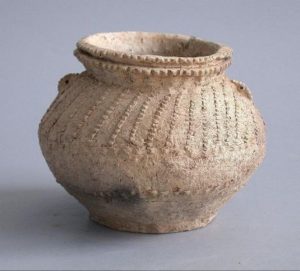
How far back containers go in pre-history is impossible to say, though no doubt it’s very far indeed. Those early human groups who traveled in small, mobile bands across the landscape are known as hunter-gatherers, after all, and what is gathered must be carried. We can guess that woven baskets were primeval; and that the skins of animals were sewn into sacks early on. That neither of these inventions presented a long-term storage solution wasn’t problematic. The nomadic character of paleolithic life meant that such technology wasn’t really required.
All this changed with the emergence of agriculture sometime after 9000 BCE. The opportunistic harvesting of wild vegetation and later the domestication of feral grasses were the first steps, but settled, proto-urban life became possible only when the precious cereal surplus could be safely stored in containers impervious to air, water, and vermin. You might say that the ceramic revolution completed the agricultural revolution by giving its products durability. In so doing, the fired pottery vessel – in all its permutations — became the sine qua non of civilized life.
Wine comes about naturally enough, as wild yeasts convert sugars to alcohol and CO2. But after this initial stage, human intervention is required if it’s not to make a headlong dash for what Nature considers the finish line: vinegar. The whole art of winemaking lies in calling a halt to this mad sprint and artificially maintaining a status quo for as long as possible. While oxygen accelerates the demise of wine, the nearly airtight environment provided by a ceramic container confers a kind of qualified immortality.
We say nearly airtight because even a securely sealed pottery vessel is permeable to a degree. Oxygen molecules creep in through its fired clay walls at a rate determined by the quality of the material and workmanship. It’s this steady, measured drip of O2 that, with time, alters the chemistry of wine in ways we refer to collectively as maturation. Tannins polymerize and smooth out. Fruit and acid marry.
Once securely buttoned up, pots of wine could be put onboard ship (much the cheapest method of transport) and traded all over the Mediterranean and Black Sea coastlines. Even in the early days of seagoing navigation the trade in wine was extensive. These are all direct spin-off effects of containerization, but even this brisk trot of an overview can’t wrap up without a reference to what might be the most dramatic unforeseen consequence of all: the emergence of moderation as a hedonic strategy.
There’s little doubt that pre-ceramic people who were engaged in primitive, open air winemaking understood the desperate perishability of wine But without the means to slow its rapid deterioration (or a way to safely store it if they could), the only option for enjoying wine in this era would have been to stage one epic, hurried, no-holds-barred annual binge. In such a situation, there’s not only no incentive to exercise self-control – it would be foolish to do so. Deferring gratification to some future date makes no sense when the means of gratification won’t be there for you to abuse.
But wine stored in tightly stoppered clay jugs had a future dimension. And with wine’s new stability and durability emerged a fresh set of behaviors to govern its consumption: one that was measured, moderate and self-disciplined — a new aesthetic consonant with the regularity and security characteristic of village agriculture. Under these conditions, binging could no longer be considered an activity that rewards, while consuming at a pace that ensured stocks of wine would last to the next harvest, surely did.
Containers didn’t just shape wine. They shaped us.
-Stephen Meuse
Taste, talk and learn about wine this weekend in the FKC wine corner . . .
THURSDAY, JANUARY 30 3-6 PM – CAREFUL WITH THE STEMWARE, THERE, OG
2018 La Chapiniére, Touraine Sauvignon Blanc – $15.95
2017 Château Roland la Garde, Blaye Côtes de Bordeaux – $21.95
2017 Jean-Baptiste Senat, “La Nine” Minervois – $23.95
FRIDAY, JANUARY 31 3-6 PM – TERRA COTTA, WE HARDLY KNEW YE
2017 Bruna, Riviera Ligure di Ponente “Maje” Pigato (new vintage) – $22.95
2017 Le Casematte Terre Siciliane “Peloro” Rosso – $23.95